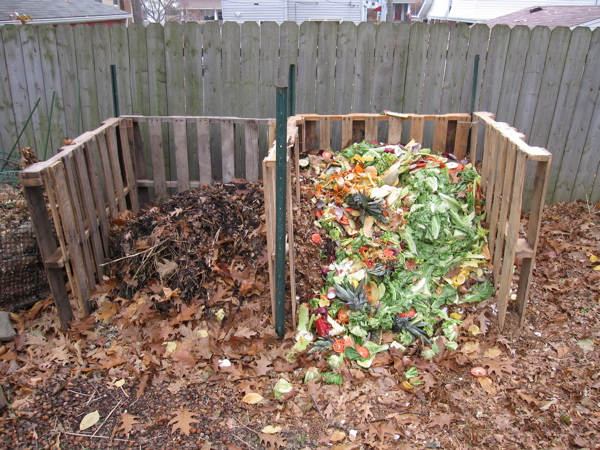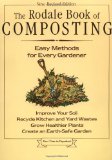
This article is part II in our series on composting for disaster prepping, and deals with effective methods for composting. Part I dealt with the benefits of composting for the prepper.
There are a variety of methods that can be employed to effectively break down organic material, but the 3 most popular methods for composting are simple compost piles, compost bins and tumblers, and vermicomposting. Every method eventually yields the same results (a reduction in organic waste and a production of rich soil that can be used for gardening) but there are guidelines that must be followed to optimize the process and maximize the speed and decomposition that occurs.
If you are interesting in composting I recommend that you get a copy of the Rodale book of compost:
It is the best book on the subject and contains all the information I am about to give you, and a lot more. Youtube is also a great resource for composting info and tips.
For compost piles and bins, the process is the same and the same elements are needed: Nitrogen rich material (commonly referred to as greens), carbon rich material (normally called browns), oxygen, and moisture. Bacteria is also a necessary part of the process, but it is not something you have to worry about introducing yourself – as long as you structure your composting process correctly the bacteria will flourish naturally.
It is important to note that no matter what you do, or how badly you mess up your composting operation, all organic material will eventually break down; so don’t worry about ‘messing it up’. We just want to make the process as quick and efficient and problem-free as possible. Don’t be afraid to experiment. Nobody is going to die if you don’t structure your compost pile perfectly.
COMPOST PILE SIZE:
For a basic compost heap you should aim for a space that is at least 3 cubic feet. Any less and the pile is unlikely to be able to maintain the temperatures required for the bacteria to flourish and quickly breakdown compost. 5’x5’x5′ is even better. The larger the pile the harder it will be for you to negatively effect it. This is the reason most commercial compost tumblers and bins under-perform. There are tricks to help them, but if you have any kind of space I recommend making a decent sized compost pile. If you don’t have space you should opt for a worm bin, as they can function just fine in small sizes.
PROPER NITROGEN / CARBON MIX
The next key step is to make sure you have an appropriate mix of nitrogen and carbon materials. Too much carbon and your pile will be dry and slow to compost. Too much nitrogen and your pile will be smelly and messy and likely go anaerobic. The easy rule of thumb is to use 3 parts browns to one part greens. If your greens are really wet or food based it is better to err on the side of too many browns rather than too little. A slow compost pile is better than a smelly pest-attracting garbage heap.
The easy way to keep the ratios right is to use a bucket or container, and for every bucket of greens you put in, put 3 buckets of browns on top.
Here are some examples of common greens and browns that you can compost:
GREENS:
Green plant material
grass clippings
manure
vegetable or fruit leftovers (banana peels, apple cores, spoiled fruit, stems and stalks, everything)
BROWNS:
Totally dead, dry leaves
Dead hay or straw
paper
cardboard
Rotten crumbling wood
The smaller the material the quicker it will compost. Do your best to shred or cut up everything as much as possible if you want to speed the process.
OXYGEN:
If there is not enough oxygen in your pile, it will still breakdown, but it will be as a result of a different type of bacteria that can survive in the anaerobic environment. This process is much slower, much stinkier, and releases methane instead of CO2. If you put a cucumber in a Ziploc bag and leave it in the garage for a couple months, the resulting satanic mush that would come out would be the result of anaerobic composting. That’s not what you want your pile to look or smell like.
For a large outdoor compost pile that is exposed on all sides you don’t have too worry too much about oxygen as it should get enough. But occasionally turning the pile with a pitchfork can help, or you can even get by with driving a stake into the pile at various intervals to allow air into the center of the pile.
In bins or tumblers oxygen can be more problematic as they are much more closed-off. Make sure bins and tumblers have plenty of air holes, and turn the tumblers more often than you would a pile.
MOISTURE:
Moisture is another component that is necessary to monitor to keep your composting bacteria happy. Too dry and the process slows way down; too wet and you may go anaerobic. If you have a perfect mix of greens and browns you may not have to ever worry about moisture levels at all. However since things rarely go perfectly, it is a good idea to sprinkle some water on top of your pile after you add your browns. Just enough to make it damp, not soggy. If your compost starts to get mushy and wet simply add more leaves or shredded paper to soak it up, and try turning it or tumbling it.
An efficiently running compost pile can reach internal temperatures of over 150 degrees Fahrenheit, and can compost your waste surprisingly quickly. But even a poorly run pile will work, and the end result is the same, so don’t let worries about not doing it well stop you from composting.
VERMICOMPOSTING:
Vermicomposting is not technically composting, as the material isn’t being broken down by natural bacterial processes, but is instead being digested by worms or grubs. For this reason the process is slightly different.
the moisture and oxygen considerations are roughly the same, but you shouldn’t turn or tumble the pile. Just add your vegetable or fruit waste and then cover with some wet shredded paper or cardboard keep them out of the direct sun. They like it pretty soggy, but not downright wet, so make sure your bin can drain if it gets rained in or overly wet.
For a tutorial on setting up a good base for a flourishing work bin you can watch this video:
Composting can be an effective tool for any preppers or homesteaders, so it is important to have a system set up already and a little knowledge about the process to properly prepare for the future.



Interesting! However, I wouldn’t let my (home) compost pile get above about 140F. There’s too cold and then there’s too hot. 🙂 You want the perfect environment for worms and microbes.
Nice article.